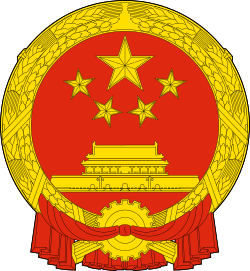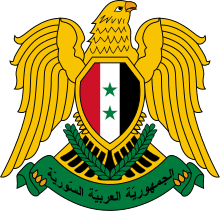China–Syria relations
 |
|
China |
Syria |
|---|---|
China–Syria relations are foreign relations between China and Syria. Diplomatic relations between both countries were established on August 1, 1956. China has an embassy in Damascus and Syria has an embassy in Beijing.
Economic relations
China and Syria have significant trade relations. In 2009, mutual trade between the two countries was worth nearly $2.2 billion according to figures from the International Monetary Fund, and similar trade volumes were expected by the Syrian Ministry of Economy for 2010. The trade, however, is almost entirely one way. Exports from Syria to China made up less than 1 percent of the total trade volume at $5.6 million, while exports from China to Syria were worth $2.2 billion making China Syria's main importer.[1][2][3] China is actively involved in Syria's oil industry. China National Petroleum Corporation is a joint venture partner with Syria's national oil company and Royal Dutch Shell in the Al-Furat Petroleum Company, the main oil producing consortium in the country.[4] The Al-Furat consortium produces some 100,000 barrels per day (bpd).[5] Sinochem is another Chinese oil company that has been very active in recent oil exploration tenders. China's CNPC and Sinopec are helping to revive output under rehabilitation contracts for small mature oil fields in Syria.[4]
Military relations
Chinese Muslims fought against Japan in World War II. In order to gain backing for China in Muslim countries, Egypt, Syria, and Turkey was visited by Hui Muslim 馬賦良[6] Ma Fuliang and Uyghur Muslim Isa Yusuf Alptekin in 1939.[7] The Hindu leaders Tagore and Gandhi and Muslim Jinnah both discussed the war with the Chinese Muslim delegation under Ma Fuliang while in Turkey İsmet İnönü met with the Chinese Muslim delegation.[8] Newspapers in China reported the visit.[9] Ma Fuliang and Isa were working for Zhu Jiahua.[10]
The bombardment of Chinese Muslims by the warplanes of the Japanese was reported in the newspapers of Syria. Afghanistan, Iran, Iraq, Syria, and Lebanon were all toured by the delegation. The Foreign Minister, Prime Minister, and President of Turkey met with the Chinese Muslim delegation after they came via Egypt in May 1939. Gandhi and Jinnah met with the Hui Ma Fuliang and Uyghur Isa Alptekin as they denounced Japan.[11]
Ma Fuxliang, Isa Alptekin, Wang Zengshan, Xue Wenbo, and Lin Zhongming all went to Egypt to denounce Japan in front of the Arab and Islamic words.[12]
In 1969, then chief of staff Mustafa Tlass led a military mission to Beijing, and secured weapons deals with the Chinese government.[13][14][15] In a move calculated to deliberately antagonize the Sovietbears to stay out of the succession dispute then going on in Syria, Mustafa Tlass allowed himself to be photographed waving Mao Zedong's Little Red Book, just two months after bloody clashes between Chinese and Soviet armies on the Ussuri river.[16][17] The Soviet Union then agreed to back down and sell Syria weapons.
In 1991 China sold a miniature neutron source reactor called SRR-1 to Syria.[18] In 2015 Syria stated its willingness to send back the uranium to China in the aftermath of its disarmament of its chemical weapons.[19]
In 1993 and 1996, China was reported to be assisting Syrian ballistic missile programs.[20][21]
On October 19, 1999, Defence Minister of China, General Chi Haotian, met with Syrian Defence Minister Mustafa Tlass in Damascus, Syria, to discuss expanding military ties between Syria and China.[22]
In August 2016 Guan Youfei, Director of the Office for International Military Cooperation of China's Central Military Commission, stated that: "The Chinese and Syrian militaries traditionally have a friendly relationship, and the Chinese military is willing to keep strengthening exchanges and cooperation with the Syrian military".[23] China had always been supporting Syrian government during the Syrian Civil War.
See also
- Ambassador of the People's Republic of China to Syria
- Foreign relations of the People's Republic of China
- Foreign relations of Syria
- Russia–Syria relations
References
- ↑ Kassab, Dana (December 2010). "Enter the Dragon". Syria Today. Retrieved 18 September 2011.
- ↑ "Syria: EU Bilateral Trade and Trade with the World" (PDF). European Commission. Retrieved 18 September 2011.
- ↑ "The World Factbook". CIA. Retrieved 17 September 2011.
- 1 2 "Factbox - Syria's energy sector". Reuters. 5 September 2011. Retrieved 18 September 2011.
- ↑ Syria, 2010. London: Oxford Business Group. 2010. p. 103. ISBN 978-1-907065-16-3.
- ↑ Hsiao-ting Lin (13 September 2010). Modern China's Ethnic Frontiers: A Journey to the West. Routledge. pp. 126–. ISBN 978-1-136-92393-7. http://wenku.baidu.com/view/b09c1314a8114431b90dd89a.html?re=view
- ↑ Hsiao-ting Lin (4 August 2010). Modern China's Ethnic Frontiers: A Journey to the West. Taylor & Francis. pp. 90–. ISBN 978-0-203-84497-7.Hsiao-ting Lin (13 September 2010). Modern China's Ethnic Frontiers: A Journey to the West. Routledge. pp. 90–. ISBN 978-1-136-92392-0.Hsiao-ting Lin (13 September 2010). Modern China's Ethnic Frontiers: A Journey to the West. Routledge. pp. 90–. ISBN 978-1-136-92393-7.
- ↑ http://www.huizu360.com/huizu/news_view.asp?tid=5&id=19276
- ↑ http://contentdm.lib.nccu.edu.tw/cdm/ref/collection/38clip/id/34722
- ↑ http://www.qh.xinhuanet.com/2009-11/27/content_18352582.htm
- ↑ http://www.xzbu.com/7/view-1606508.htm
- ↑ http://www.xzbu.com/4/view-3247116.htm
- ↑ Peter Mansfield, Royal Institute of International Affairs. Information Dept (1973). The Middle East: a political and economic survey. Oxford University Press. p. 480. ISBN 0-19-215933-X. Retrieved 2010-06-28.
- ↑ George Meri Haddad, Jūrj Marʻī Ḥaddād (1973). Revolutions and Military Rule in the Middle East: The Arab states pt. I: Iraq, Syria, Lebanon and Jordan, Volume 2. R. Speller. p. 380. Retrieved 2010-06-28.
- ↑ Europa Publications Limited (1997). The Middle East and North Africa, Volume 43. Europa Publications. p. 905. ISBN 1-85743-030-1. Retrieved 2010-06-28.
- ↑ Robert Owen Freedman (1982). The Soviet policy toward the Middle East since 1970. Praeger. p. 34. Retrieved 2010-06-28.
- ↑ Robert Owen Freedman (1991). Moscow and the Middle East: Soviet policy since the invasion of Afghanistan. CUP Archive. p. 40. ISBN 0-521-35976-7. Retrieved 2010-06-28.
- ↑ SRR-1
- ↑ Syria agrees to return highly enriched uranium to China
- ↑ Dinshaw Mistry (2005). Containing Missile Proliferation: Strategic Technology, Security Regimes, and International Cooperation in Arms Control. University of Washington Press. p. 106. ISBN 0-295-98507-0. Retrieved 2010-06-28.
- ↑ Anthony H. Cordesman (1999). Containing Iran's military forces in transition: conventional threats and weapons of mass destruction. Greenwood Publishing Group. p. 262. ISBN 0-275-96529-5. Retrieved 2010-06-28.
- ↑ "China defense minister visits Israel". World Tribune. Thursday, October 21, 1999
- ↑ "China 'to provide aid, enhance military training' in Syria – top army official". RT. 16 August 2016. Retrieved 17 August 2016.

